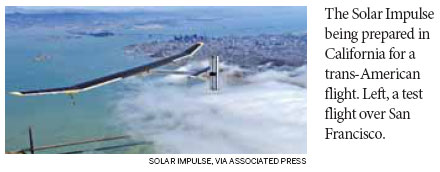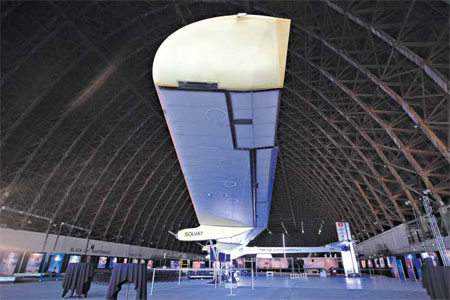Flying solar night and day Diane Cardwell
Updated: 2013-06-16 07:41
By Mountain View, California(The New York Times)
|
|||||||
|
The Solar Impulse being prepared in California for a trans-American flight. Left, a test flight over San Francisco. solar impulse, via Associated Press |


Plane's goal: to cross the United States using only the sun's energy as fuel
When Bertrand Piccard was growing up in Switzerland, heady discussions about the boundless potential for human endeavor were standard fare.
His grandfather, a physicist and friend of Albert Einstein and Marie Curie, had invented a special capsule so he and a partner could be first to reach the stratosphere in a balloon. His father, an engineer, helped design the submarine that made him and an American naval officer the first to plunge undersea to the deepest spot on the earth's crust.
"All the most incredible things seemed to be completely normal," Mr. Piccard, a psychiatrist trained in hypnosis, said at Moffett Field at the NASA Ames Research Center here, as he prepared for his next expedition. "I thought this was the normal way to live."
He went on to become part of the team that was first to circumnavigate the globe nonstop in a balloon. But when a propane shortage nearly ended his record-setting ride in 1999, he began dreaming of a way to fly day and night without fuel, an idea that has resulted in a featherweight solar airplane that set out in its voyage across the United States on May 3.
The Solar Impulse is not the first sun-powered plane to fly; its chief distinction is its ability to go through the night.
While it could be decades, at least, before ordinary travelers board solar electric planes, the technology is under consideration for drones, which risk damage when they land to refuel.
And some of the technologies developed for Solar Impulse - which has a wingspan matching that of a Boeing 747 but the weight of a midsize car - are already set for commercial use, including the special batteries used to store the solar energy and the foam that insulates them.
The Solar Impulse cockpit fits only one, so Mr. Piccard is trading legs of the journey with his partner, Andre Borschberg, flying at about 73 kilometers per hour for 18 to 20 hours at a time. The aircraft could theoretically fly continuously, but the pilots- despite Mr. Piccard's apparent skill at self-hypnosis and Mr. Borschberg's explorations of yoga and meditation - cannot. The plane's extreme sensitivity to turbulence demands a pilot's direct attention. "We have a sustainable airplane; now we have to build a sustainable pilot," said Mr. Borschberg.
The men have stopped in Phoenix, Dallas and St. Louis. They plan a stop in Washington, D.C., before a final landing at Kennedy Airport in New York near the end of June. The voyage is a precursor to a planned trip around the globe in 2015 for which the team is building a second plane, adding adjustments like an autopilot and reclining seat, to help them fly for as many as five days straight.
The two met after Mr. Piccard presented his idea for fuel-free flight to the Swiss Institute of Technology, which put Mr. Borschberg in charge of studying the project. He ended up overseeing the aircraft's design and construction, including its nearly 12,000 solar cells. Mr. Piccard turned to raising the $140 million in financing and sponsorship to support it.
Constructed of a carbon fiber frame, monocrystalline silicon solar panels and a sheer, silver carbon wrapping, the plane is tough enough to reach about 9,100 meters but so fragile you could put a finger through it.
"Everything is so efficient that we can fly only with the sun that we collect in the airplane," Mr. Borschberg said.
Mr. Piccard said his ballooning experience taught him "different ways of thinking, different ways of reacting, different ways of understanding situations."
"In life," he said, "you have to drop your certitudes, your common assumptions, your convictions sometimes, to be more flexible to adapt to the unknown."
The New York Times
(China Daily 06/16/2013 page9)
